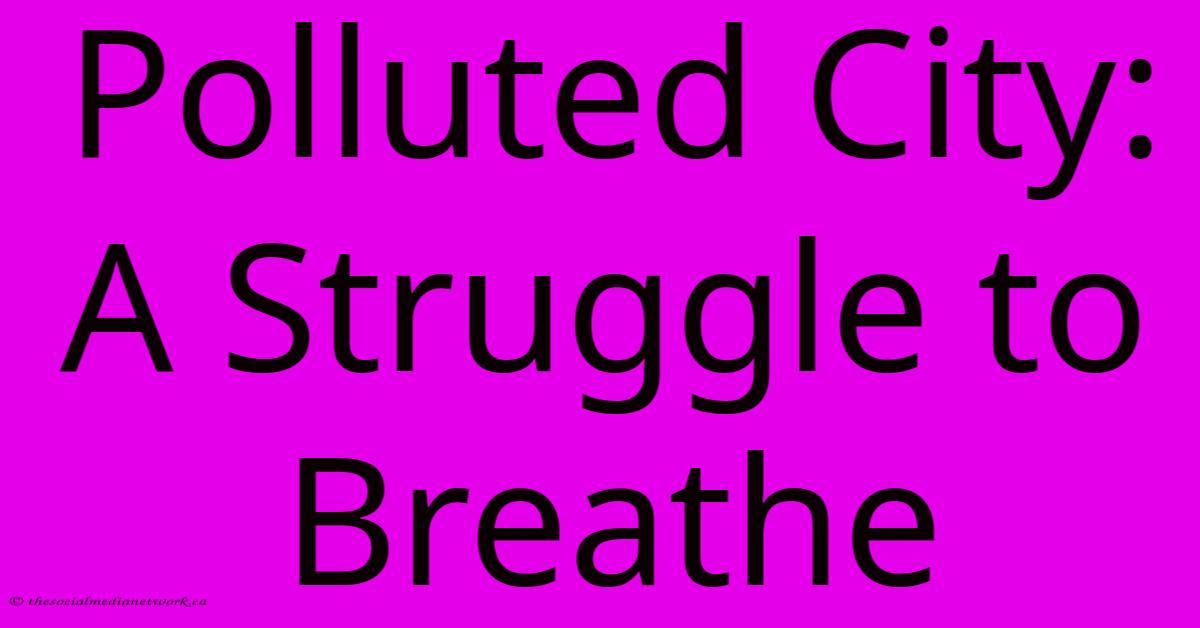Polluted City: A Struggle To Breathe

Discover more detailed and exciting information on our website. Click the link below to start your adventure: Visit Best Website meltwatermedia.ca. Don't miss out!
Table of Contents
Polluted City: A Struggle to Breathe
The air hangs heavy, a thick, grey blanket stifling the city. This isn't just a gloomy day; this is the reality for millions living in polluted cities worldwide. The struggle to breathe clean air is a fight for survival, impacting not only our lungs but our overall health and the future of our planet. This article delves into the causes, consequences, and potential solutions to this pressing global issue.
The Suffocating Sources of Urban Pollution
Several factors contribute to the alarming levels of air pollution choking our cities:
1. Vehicle Emissions:
The most significant contributor is often vehicular exhaust. Millions of cars, buses, and trucks release harmful pollutants like nitrogen oxides (NOx), particulate matter (PM2.5 and PM10), and carbon monoxide (CO) into the atmosphere daily. Older vehicles, lacking modern emission control systems, are particularly problematic. Traffic congestion exacerbates this issue, creating localized pockets of extremely high pollution.
2. Industrial Activities:
Factories and industrial plants release a cocktail of toxic substances, including sulfur dioxide (SO2), heavy metals, and volatile organic compounds (VOCs). These emissions are often unregulated or inadequately controlled in developing nations, leading to severe air quality degradation.
3. Construction and Demolition:
Construction sites generate significant dust and particulate matter, contributing to poor air quality, particularly in rapidly developing urban areas. The lack of proper dust control measures further worsens the problem.
4. Burning Fossil Fuels for Energy:
Power plants that rely on coal and other fossil fuels release enormous quantities of pollutants into the air. This is a major contributor to smog and acid rain, negatively impacting both air and water quality.
5. Domestic Sources:
Household activities, such as cooking with wood or coal stoves and burning garbage, also release harmful pollutants. This is particularly prevalent in low-income communities lacking access to cleaner energy sources.
The Devastating Consequences of Air Pollution
The health impacts of living in a polluted city are far-reaching and severe:
1. Respiratory Illnesses:
Air pollution is a leading cause of respiratory diseases like asthma, bronchitis, and pneumonia. Inhaling polluted air inflames the lungs and airways, leading to chronic coughing, wheezing, and difficulty breathing. Children and the elderly are particularly vulnerable.
2. Cardiovascular Diseases:
Fine particulate matter can enter the bloodstream, increasing the risk of heart attacks, strokes, and other cardiovascular problems. Air pollution accelerates atherosclerosis (hardening of the arteries), significantly impacting heart health.
3. Cancer:
Exposure to certain air pollutants, such as benzene and particulate matter, is linked to an increased risk of lung cancer and other cancers. Long-term exposure increases the likelihood of developing these life-threatening diseases.
4. Reduced Life Expectancy:
Studies have consistently shown a correlation between air pollution levels and reduced life expectancy. Living in a heavily polluted city can significantly shorten your lifespan.
5. Economic Burden:
The economic cost of air pollution is substantial, encompassing healthcare expenses, lost productivity, and environmental damage. The burden falls heavily on both individuals and the healthcare systems.
Breathing Easier: Solutions and Strategies
Tackling this global challenge requires a multi-pronged approach:
1. Transition to Renewable Energy:
Investing in renewable energy sources like solar and wind power reduces reliance on fossil fuels, a major contributor to air pollution.
2. Improve Public Transportation:
Promoting efficient and affordable public transportation systems reduces reliance on private vehicles, thereby decreasing traffic congestion and emissions.
3. Stricter Emission Standards:
Implementing and enforcing stricter emission standards for vehicles and industrial plants is crucial in reducing pollutants released into the atmosphere.
4. Green Urban Planning:
Creating green spaces and urban forests helps absorb pollutants and improve air quality within cities.
5. Public Awareness Campaigns:
Educating the public about the health risks associated with air pollution and promoting individual actions to reduce their carbon footprint is vital.
The fight for cleaner air is a collective responsibility. By implementing these solutions and promoting global cooperation, we can create healthier and more sustainable cities for generations to come. The struggle to breathe should not define our urban landscapes; instead, let us strive for a future where clean air is a fundamental right for all.

Thank you for visiting our website wich cover about Polluted City: A Struggle To Breathe. We hope the information provided has been useful to you. Feel free to contact us if you have any questions or need further assistance. See you next time and dont miss to bookmark.
Featured Posts
-
Update Beirut Schools Closed Until December
Nov 26, 2024
-
Herberts Growth 2024 Leadership
Nov 26, 2024
-
Printemps In Paris Now Crypto
Nov 26, 2024
-
Jdts Cold Weather Concerns
Nov 26, 2024
-
Mmcv Supporting Red Ones Green Goals
Nov 26, 2024
